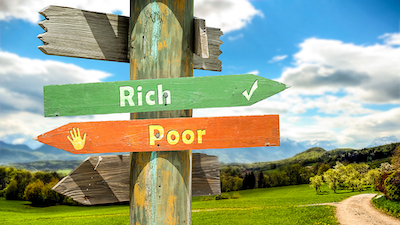The divide between the rich and the poor is more than just the amount of money in their bank accounts. It’s a chasm that spans across various aspects of life, including social impact, health, entertainment, travel, education, and many more. This article delves into the contrasting lives of the rich vs poor, offering a window into how these differences shape experiences, opportunities, and challenges.
Social Impact
The disparity between the rich and the poor often leads to a gap in social interactions and networks. Wealthy individuals usually have access to elite social circles, which can provide opportunities for business, leisure, and philanthropy. These networks can be powerful, offering support and opening doors that might remain closed to others. On the contrary, those living in poverty might find their social networks limited to their immediate community, which, while tight-knit, may lack the resources and opportunities to significantly alter their socioeconomic status.
Health
When it comes to health, the gap between the rich and the poor can be stark. Wealth affords access to better healthcare, including preventative services, leading to healthier lifestyles and longer life expectancy. The rich have the means to pay for private healthcare, access to specialists, and can afford healthier food options. In contrast, the poor often face challenges in accessing quality healthcare. They might rely on underfunded public health services, where long waits and limited resources can affect the level of care. Additionally, economic constraints may limit their access to healthy food options, further exacerbating health disparities.
Entertainment
Entertainment options also vary greatly between the rich and the poor. Those with wealth can indulge in high-end entertainment, such as traveling to exotic locations, attending premier events, and enjoying luxury dining. Their financial freedom allows them to explore a variety of hobbies and interests, from art collecting to sailing. In contrast, the entertainment options for those living in poverty are often limited to more affordable or free activities. While these can still provide joy and relaxation, the range and quality of accessible entertainment can be significantly narrower.
Travel
Travel is another area where the divide is evident. For the wealthy, the world is their oyster. They can afford to travel frequently, staying in luxury accommodations and experiencing different cultures and cuisines. Their travel experiences are often about comfort, exploration, and leisure. For the poor, travel is often limited to necessary trips due to financial constraints. Vacations and leisure travel are luxuries that are often out of reach, making their world much smaller.
Education
Education is perhaps one of the most critical areas where the divide between rich and poor has long-term implications. Wealthy families can afford private education, tutoring, and extracurricular activities that enhance learning opportunities. These advantages often translate into better academic performance, higher education, and more lucrative career opportunities. In contrast, the poor are more likely to attend underfunded public schools with fewer resources, larger class sizes, and less individual attention. This disparity can limit their educational achievements and career prospects, perpetuating the cycle of poverty.
Bridging the Gap
While the differences between the rich and the poor are significant, efforts are being made to bridge this gap. Governments and NGOs around the world are working to improve access to healthcare, education, and economic opportunities for those in poverty. Social initiatives are aiming to create more inclusive networks that offer support and opportunities to those from less privileged backgrounds. However, there is still much work to be done to ensure that everyone, regardless of their financial status, has the opportunity to lead a healthy, fulfilling life.
All is not lost, however, there are some positives to being poor:
While poverty is undeniably associated with many challenges, including limited access to healthcare, education, and other essential services, there are certain perspectives and life lessons that might be viewed as advantages in a non-material sense. Here are a few considerations:
- Resilience and Creativity: Living with limited financial resources often requires individuals to be resourceful and creative in finding solutions to daily challenges. This can foster a strong sense of resilience, as individuals learn to navigate and overcome obstacles with fewer means at their disposal.
- Valuing Non-material Wealth: Experiencing poverty can lead to a greater appreciation for non-material aspects of life, such as family, community, and personal relationships. Individuals may place a higher value on experiences and connections over material possessions.
- Empathy and Solidarity: Experiencing or being close to poverty can cultivate a deep sense of empathy for others facing similar challenges. This can lead to a strong sense of solidarity and community among those who have faced or are facing economic hardships, as they understand the struggles and support each other.
- Motivation for Change: For some, experiencing poverty firsthand can be a powerful motivator to strive for change, both in their personal lives and in the broader society. It can inspire individuals to pursue education, advocate for social justice, or work towards economic reforms that address the root causes of poverty.
- Simplicity and Mindfulness: Living with less can encourage a simpler lifestyle that focuses on the essentials, potentially leading to a more mindful and less consumption-driven approach to life. This can also result in a lower environmental footprint.
- Community Support and Networks: In many cases, communities facing economic hardships develop strong networks of support where members help each other with resources, advice, and emotional support. These networks can offer a sense of belonging and community resilience.
However, it is important to note that these potential “advantages” do not negate the significant and often severe disadvantages that come with poverty, including poor health outcomes, limited access to education and opportunities, and higher levels of stress and anxiety. The discussion of any benefits does not overlook the urgent need for systemic solutions to address poverty and inequality. The goal should always be to ensure that all individuals have access to the resources and opportunities they need to lead healthy, fulfilling lives.
Is less really more? Check out this audiobook: Minimalism: Live a meaningful life at Audible.
Or, if you’re determined to get rich, start with a good foundation: The Millionaire Next Door audiobook also at Audible.
As an Amazon Associate, I earn from qualifying purchases.












